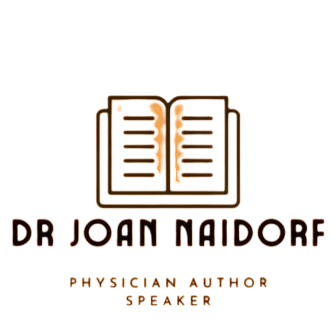#72 Pathological: a Tale of Misdiagnosis and Punctuation?!
This review first appeared in The DO Magazine February 2023
by Joan Naidorf, DO
In Sarah Fay’s memoir “Pathological: The True Story of Six Misdiagnoses,” (HarperOne) several important issues are raised about the validity of the Diagnostic and Statistical Manual of Mental Disorders (DSM), the inappropriate role of pharmaceutical companies in the testing and financial support of physician researchers and the overuse of mental health diagnoses to treat and to define various patients.
Hardback edition photo by Joan Naidorf
She backs up her opinions by citing numerous research studies while she tells the rather complex narrative history of her own life. As if this wasn’t enough, she also weaves in the history and explanation of grammar and punctuation marks as both metaphor and evidence of the interpretation and misinterpretation of the written and spoken word.
An imperfect document
Fay’s story begins with her recollections of her adolescent self as having difficulty and pain around eating. Possibly, for this reason, she avoided eating and was underweight. At an early age, she was given the diagnosis of anorexia nervosa by her pediatrician and tells the cautionary tale of living into her diagnosis.
As an adult, Fay realized that the diagnoses she had been given were based on one of the many editions of the DSM. Rather than a reliable diagnostic tool used for treatment, she discovered that it was an imperfect document with a legacy is rooted in racism, sexism, homophobia and the influence of the pharmaceutical companies seeking profits.
Fay journalled frequently, so she has detailed recollections of many of her thoughts and feelings throughout her life. As a talented writer, her descriptions of her various symptoms of anxiety, hyperactivity and depression are invaluable to mental health professionals and physicians who may not have experienced these specific symptoms ourselves.
Fay also describes her struggles with starting and tapering off of various medications. During a difficult period of withdrawal from taking SSRI medications, Fay writes:
“The withdrawal symptoms seemed to build, climax and now scraped along. Gone were the hallucinations, paranoia, sweating, agitation, nightmares, the brain shivers and shudders and zaps, but not the anxiety, confusion, irritability, insomnia or crying spells, which seemed minor in comparison.” (pp. 190)
This horror just describes the discontinuation one of her medicines.
Over the following decades, Fay is diagnosed or misdiagnosed with attention deficit hyperactivity disorder (ADHD), obsessive-compulsive disorder (OCD), depression, anxiety and bipolar disorder. She suspects that her conflicting diagnoses, the labels she's been given, and the high doses of drugs she's taking are making her feel worse, not better. She learns about the uncertainty of mental health diagnoses that rely primarily on the patient’s description of her symptoms.
Overdiagnosis
Many of her doctors, notably psychiatrists, didn’t take thorough histories. Fay relates instances of multiple visits with doctors who ask the wrong questions and make hasty assumptions. At many times throughout her story, maybe because she hasn’t been directly asked, Fay withholds information regarding her prodigious alcohol intake and her suicidal thoughts. Not surprisingly, her physicians reached incorrect conclusions.
Fay proposes that diagnosing mental illness, which has evolved with the ever-lengthening editions of the DSM, may be to blame for the overdiagnosis of mental health disorders. She blames the uncertainty of mental health diagnoses coupled with pseudoscience in the DSM. A DSM diagnosis ensures reimbursement from insurance companies when a medical professional places the codes into a patient's chart. She believes the spectrum of human emotions has been “pathologized” to the point of assigning nearly everyone a DSM diagnosis.
As she describes the college students she interacted with in an undergraduate course,
“My students liked talking about mental health, which they referred to as mental illness. Given how many of them had come to my office hours to share that they suffered from ADHD or anxiety or depression or were bipolar, I assumed that was why. They were a pathologized generation, used to being told that distraction meant ADHD, sadness meant depression, and worry meant an anxiety disorder.” (pp. 182)
The author tries to debunk some of the persistent theories and myths about “chemical imbalances” causing mental health diseases. She references research highlighting the persistent confusion around the apparent improvement in many disorders by taking medications. After taking Ritalin improved her ADHD symptoms, she writes that her doctor used her clinical improvement on the medication “to prove, not only the unproven diagnosis but also its unproven cause.” (pp. 183) If a patient improves on a certain medication, does that prove that she had the specific illness?
Fay goes on to document pharmaceutical companies’ connections to the compilation of the DSM and direct-to-patient marketing. The underlying idea that there is some biological factor behind the DSM diagnoses helps sell more medicines, she notes.
As she writes, “Psychiatry’s bible actually offers no treatment suggestions at all. It just clusters symptoms and theorizes mental illnesses with which to label us and sends us on our way.” (pp. 185) Unfortunately, the way that physicians and mental health professionals have been diagnosing mental health illness for several decades is firmly rooted in this flawed tool.
Fay suggests that having a DSM diagnosis may cause patients with mental health issues to live life as if they are a diagnosis. She points out that the DSM is a compendium describing variations of human behavior with descriptions and checklists that aide in assigning a diagnosis. The diagnosis is one professional’s opinion, not a fact. It took a while for her to recognize that she and millions of others, are people who exhibit extremes of normal human emotions, may not actually have the related diagnosis, just some of the symptoms.
The challenges of mental health diagnosis in modern medicine
Physicians reading “Pathological” will recognize some of the frustrations we have with the system and the nature of diagnosing and treating mental illnesses. Diagnostic criteria are imperfect and always changing in every medical field. We care about getting it right and helping our patients, but we have limited time with which to interview them.
We need some diagnosis to place on the chart for treatment and reimbursement processes. The consequences of underdiagnosing or failing to treat a person with depression and suicidal ideations can be so serious that the ramifications of overtreatment seem trivial.
Patients are not their diagnoses. They are complex human beings who have diagnoses like sickle cell anemia or schizophrenia. In her book, Fay reminds us to look and listen more closely to our patients before pigeonholing them into stigmatizing diagnoses. The author promises us a sequel to “Pathological” in which she will narrate her full recovery from serious mental illness. I look forward to reading the rest of the story.



